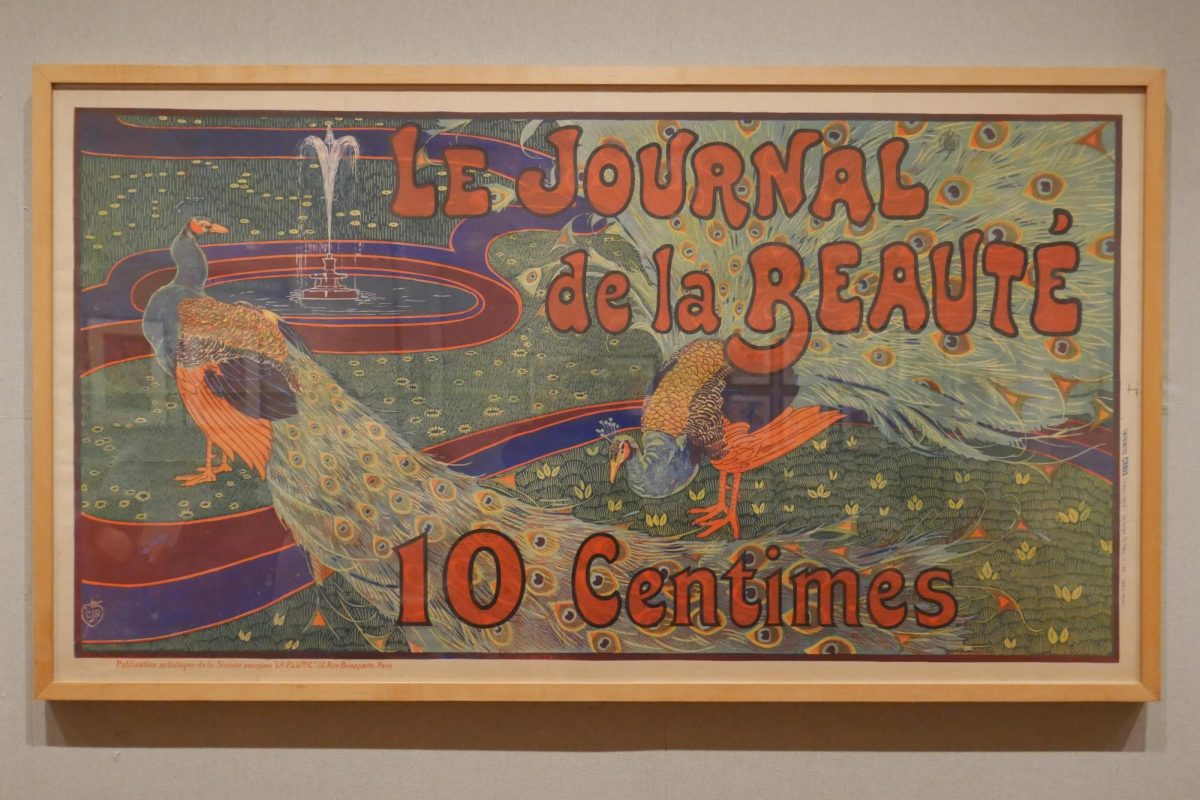Centered in luscious vines, an ancient half-man, half-goat Greek god cups the face of a mystical woman. Mesmerized, they stare into each other’s eyes in Will H. Bradley’s 1894 advertisement for Tom Hall’s book of poems, “When Hearts are Trumps.” Bradley’s advertisement is currently on view in The Metropolitan Museum of Art’s most recent exhibition, “The Art of the Literary Poster: Works from the Leonard A. Lauder Collection.”
“The Art of the Literary Poster” consists of more than 40 pieces ranging from preliminary drawings to finished advertisements. This exhibition showcases poster advertisements for magazines, newspapers and books, including works by American artists such as Joseph Christian Leyendecker, Edward Penfield and Ethel Reed. By organizing the collection thematically, the exhibition provides a comprehensive view of the development of literary posters over the course of four decades, beginning in the late 19th century.
The exhibition opens with “Beginnings,” a section displaying monthly covers from Lippincot’s Magazine and Harper’s Magazine with varying themes. The displayed magazines serve as a playful portrayal of each respective month, often featuring a person engrossed in a book. Penfield’s 1894 “Harper’s, July,” for example, depicts a woman reading while lighting fireworks that spell out the word July, exemplifying the artist’s celebrated use of graphic design and modern aesthetics.
These advertisements were targeted toward the wealthy buyers who could afford the magazines, but the hobbies depicted in the posters — reading, cycling, tennis and others — encouraged readers of various social statuses to emulate this lifestyle. “Beginnings” perfectly sets up the broader theme of changes and transitions in the exhibition by painting a picture of an overall desire for class mobility within the country at the time.
“The Art of the Literary Poster” also explores representations of the American West. The inclusion of Western motifs in the exhibition acts as a distinctive testimony to the West’s coveted status in the early 20th century. Cowboys, sunsets, railroads and a less urban lifestyle became hallmarks of the Western lifestyle, and the inclusion of these themes represents a transition in societal aspirations during the early 1900s.
Transitioning from realism to impressionism in the “Fantasy” section of the exhibition, viewers are greeted with posters of people with exotic animals, natural landscapes and floral motifs. The prints in this section reflect a departure from traditionalist art and a shift toward more whimsical and decorative styles, displaying the altering landscape of literary art at the turn of the century through its desire for natural beauty.
In 1897, Paris-based publisher LA PLUME commissioned artist Louis John Rhead to create the lithographic panel which was later used as an advertisement for the Le Journal de la Beauté. The panel features two peacocks — common motifs in the Art Nouveau movement, recognized for their vibrant beauty. Behind the peacocks is a decorative landscape with a long, winding road leading to a spouting fountain. The letters of “Le Journal de la Beauté” are bubbly and shaded with orange. The lettering helps create a lighthearted feeling in the advertisement, which was a true highlight of the posters shown.
A similarly whimsical style is carried on by Maxfield Parrish in “The Century, August, Midsummer Holiday Number” In this piece, a young woman sits and gazes toward a star-filled sky, seemingly lost in thought. Midsummer is often associated with being a point of reflection and time to reconnect with nature, and the piece perfectly depicts this while highlighting elements of escapism and fantasy.
In a history-rooted journey through the evolution of literary posters, viewers are invited to ponder the intricate artistic and cultural shifts that defined the 19th and 20th centuries. Despite its modest size, the exhibition serves as a poignant reflection of the desire for change among Americans at the time.
Contact Marisa Sandoval at [email protected].






















































































































































